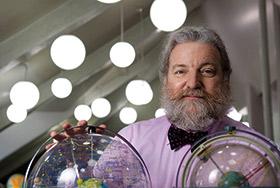Shooting for the stars: Mattapoisett native becomes AIP Board Chair
Mattapoisett native David J. Helfand didn’t originally plan to become the Board Chair for the American Institute of Physics, nor has he always wanted to be an astrophysicist but he ended up doing just that. An astrophysicist who grew up in Mattapoisett and has taught at Columbia University for 42 years, he was recently appointed to Board Chair for the AIP.
Helfand went to Old Rochester Regional High School. After graduating high school at 17, he went to Amherst College, intending to be a theater major. A year into college, for reasons he said he can’t remember, Helfand took a course on astronomy where his interest in the physics of the universe began. After taking a second course on astronomy, he realized he wanted to pursue it as a career.
At one point Helfand and seven other members of his astronomy class went to an observatory in Arizona. During his trip, the astronomer there compared astronomy to symphony orchestras and opera companies.
“I really liked that idea; that studying this completely inapplicable subject that is trying to understand our place in the universe was equivalent to Beethoven’s symphony,” Helfand said, “That’s why I became an astronomer.”
Helfand would appear on the Discovery Channel’s “Science News” where he would talk about recent discoveries related to the universe and astrophysics. Helfand was also involved with National Geographic, doing lectures on their expedition cruises. On one cruise he visited the South Georgia islands in the Arctic, where the night sky was perfect to observe stars. Helfand would take people outside on the cruise ship at night time to share his knowledge of the stars and the universe.
The astrophysicist would also give talks on climate change.
Helfand spent his time at Columbia University studying neutron stars, collapsed cores of giant stars formed after an explosion. Helfand is particularly fascinated by the gravitational waves, or ripples in the fabric of space and time, which neutron stars produce when they collide with each other.
As Board director, Helfand and the American Institute of Physics plan to develop a center in the next five or ten years focused the history of physics. Helfand also plans to work with the Institute and college students to develop ways to communicate with the public about physics in a way they can understand.
Often, said Helfand, scientists fail to effectively communicate what their technical scientific terms mean and expect people to understand them.“We seem to be going backwards rather than forwards in communicating scientific ideas,” he said.
As a professor, he often reminds his students to celebrate their insignificance compared to the vast and ancient universe. “People tend to be very focused on themselves and their immediate surroundings,” said Helfand, “When you recognize that the planet has been here for 4.6 billion years and it’s going to be here for another 5 billion years and the human species has only been around a couple of hundred thousand years ... I think it helps to place one’s day-to-day mundane problems into perspective.”












